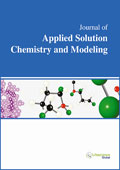jascm
Abstract : Adsorption Dyes in Aqueous Solutions by Activated Carbon-Based White Wood
|
|
Abstract: Among the dyes, the blue disperse and reactive orange have well recognized toxicities and dissemination facilities in the different compartments of the environment. Various regulations set maximum permissible levels of these dyes in both drinking water and industrial discharges. In order to comply with thesevarious standards, many depollution techniques have been developedin recent years.Our choice is to carry out the adsorption ofactivated carbon based wood because this adsorption has main advantages of being more effective and easy to implement. Furthermore, the use ofless expensive non-conventional adsorbents guarantees its economic feasibility. However, this elimination is affected by several parameters related to the carbon atom, to the solution and the active suspension. The adsorption results for Disperse Blue and orange reactive with activated charcoal showed adsorption capacity up to 4.8 mg / g and 12.4 mg / g. The study showed that the adsorption of activated carbon prepared from wood is more effective for the removal of these two wastewater dyes. Download Full Article |
Abstract : EDITORIAL: Conversion of Biomass into Biofuels with Supercritical Fluids
|
|
Download Full Article |
Abstract : Energy Production by Hydrothermal Treatment of Liquid and Solid Waste from Industrial Olive Oil Production
|
|
Abstract: This work studies the use of olive oil mill waste (OMW) treated as subcritical or supercritical water to produce both, a biofuel by liquefaction and a gas fuel by gasification. The increasing amount of OMW, both liquid and solid, is becoming a serious environmental problem. This wastewater is highly resistant to biodegradation and contains a wide variety of compounds such as polyphenols, polyoils, organic acids, etc, that require depuration treatments to remove the odour and pollutant load before being discharged. This work studies both, liquefaction and gasification of OMW streams in subcritical and supercritical water in different batch reactors at temperatures between 200 and 530 ºC and pressures between 150 and 250 bar. This study also tests the effectiveness of various types of homogeneous (KOH 0.01 g/gsample dry) and heterogeneous catalysts (TiO2, V2O5 and Au-Pd 0.1-0.5 g/gsample dry) for supercritical water gasification (SCWG) and studied the way they affect biomass conversion yields. It also covers the effect that the use of different organic compound concentrations (23, 35, and 80 g O2/l of chemical oxygen demand concentration (COD)) and compositions (mixtures of solid and liquid OMW) has on energy production results. A maximum of 82% oil yield was obtained from the hydrothermal liquefaction of OMW under optimum conditions (330 ºC, 150 bar, 23 g O2/l as initial concentration and 30 minutes reaction time). Meanwhile, a yield of 88.6 mol H2/kgOMW dry was obtained when Au-Pd was used as a catalyst for the gasification of OMW supercritical water. Keywords: Gasification, liquefaction, supercritical water, subcritical water, olive mill wastewater, biofuel, gas fuel.Download Full Article |
Abstract : Production and Characterization of Energy Materials with Adsorbent Properties by Hydrothermal Processing of Corn Stover with Subcritical H2O
|
|
Abstract: This work aims to investigate the effect of temperature on the process performance of hydrothermal processing (HTC) of corn Stover with subcritical H2O and on the morphology of solid products. The experiments were carried out at 200, 225 and 250 ºC, reaction time of 240 minutes, heating rate of 2.0 ºC/min, and biomass to water ratio of 1:10, using a pilot scale stirred tank reactor (STR) of 5 gallon, operating in batch mode. The process performance analyzed by computing the yields of solid and liquid reaction products (RLP). The aqueous phase (H2O + RLP) was physicochemical analyzed for pH and total carboxylic acids, expressed as total acetic acid content. The chemical compositions of carboxylic acids, furfural, and hydroxymethylfurfural (HMF) in the aqueous phase determined by GC-MS and HPLC. The results showed solid yields ranging from 57.39 to 35.82% (wt.), and liquid reaction products (RLP) yields ranging from 39.53 to 54.59% (wt.). The solid phase products were characterized by scanning electron microscopy (SEM), energy dispersive X-ray spectroscopy (EDX), and X-ray diffraction (XRD). The chemically activated (2.0 M NaOH) solid phase energy material obtained by HTC at 250°C, applied as adsorbent to investigate the capacity and/or efficiency to adsorb acetic acid from 1.0 to 4.0 g/L model solutions at 25 °C. The solid phase yield decreases along with the temperature, showing an inflection region between 200 and 225 °C, whereas a drastic change takes place, while that of liquid phase increases, showing also a drastic change between 200 and 225 °C. The total acetic acid content of aqueous phase varied from 4064 to 5387 mg/L, while the pH from 3.77 to 3.91. The GC analysis identified the presence of volatile carboxylic acids, particularly acetic acid, in concentrations between 4020 and 5040 mg/L. HPLC identified the presence of furfural and hydroxymethylfurfural, whose concentrations decrease exponentially and linearly along with the temperature between 686.7 and 0.0, and 443.9 and 0.0 mg/L, respectively, being both compounds not detectable at 250 °C. The elemental/ultimate analysis of solid products shows that carbon content increases, while the oxygen and hydrogen contents decrease, along with the temperature. The H/C and O/C ratios decrease linearly as process temperature increases, and the high heating value (HHV) of solid reaction products, an energy densified material, changes sharply between 200 and 225 °C, showing an increase with temperature. The SEM, EDX, and XDR indicates a change on the morphology and mineralogical phases present in solid reaction products with temperature, particularly at 250 °C. The activated solid phase has proven to be very selective to adsorb acetic acid, showing that recovery of acetic acid from hydrothermal carbonization/liquefaction aqueous solutions is feasible by using a multistage-stage adsorption process in series. Keywords: HTC, Subcritical H2O, Corn Stover, Energy Materials, Morphology, Adsorption.Download Full Article |






















